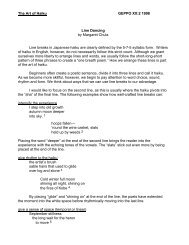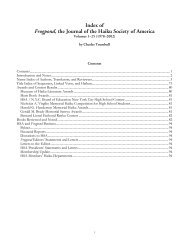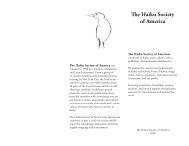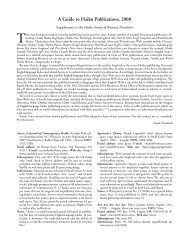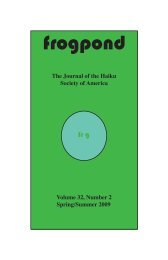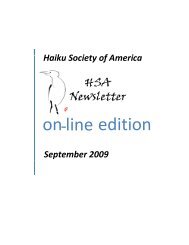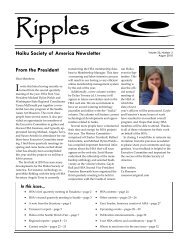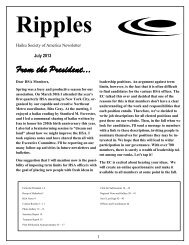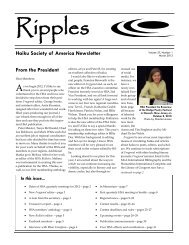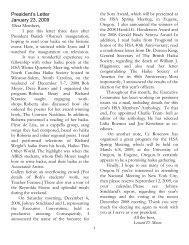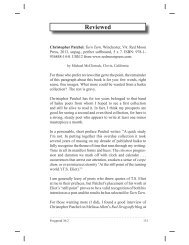Frogpond 34.3 • Autumn 2011 (pdf) - Haiku Society of America
Frogpond 34.3 • Autumn 2011 (pdf) - Haiku Society of America
Frogpond 34.3 • Autumn 2011 (pdf) - Haiku Society of America
You also want an ePaper? Increase the reach of your titles
YUMPU automatically turns print PDFs into web optimized ePapers that Google loves.
interest is always the same: in how poems work, precisely, in<br />
why they affect us they do, and in bringing in whatever background<br />
helps us read more vulnerably, openly, accurately, and<br />
deeply. I think this is especially needed for haiku. We teach<br />
haiku to third graders, but in fact it’s an art form that requires<br />
some real initiation to be truly practiced or read. <strong>Haiku</strong> are the<br />
most immediate <strong>of</strong> art forms in one way, but in another, they<br />
are slip knots that you need to know the knack <strong>of</strong>, to untie fully.<br />
The more I learn about haiku, the more I feel how much I have<br />
not yet learned. It is bottomless, really. Any good poetry is.<br />
CE: In your essay, you address the wide popular interest in<br />
non-literary haiku and you specifically reference the thousands<br />
<strong>of</strong> haiku written about Spam (“Spamku”) and posted<br />
online. You foreground that, “... to write or read with only this<br />
understanding is to go back to what haiku was before Bashō<br />
transformed it: ‘playful verse’ is the word’s literal meaning.<br />
Bashō asked for more: to make <strong>of</strong> this brief, buoyant versetool<br />
the kinds <strong>of</strong> emotional, psychological and spiritual discoveries<br />
that he experienced in the work <strong>of</strong> earlier poets. He<br />
wanted to renovate human vision by putting what he saw into<br />
a bare handful <strong>of</strong> mostly ordinary words, and he wanted to<br />
renovate language by what he asked it to see.” To what extent<br />
do you find contemporary English-language haiku poets continuing<br />
to follow this approach?<br />
JANE: It seems to me that the best contemporary haiku writers<br />
are in Bashō’s lineage, and Issa’s and Buson’s. This is <strong>of</strong><br />
course my own definition <strong>of</strong> “best.” It’s fine that many poets<br />
do other things as well. But the central work <strong>of</strong> poetry is<br />
the same everywhere—from Sappho to Akhmatova, Tu Fu to<br />
Frank O’Hara, lyric poets magnify and enlarge and open our<br />
relationship to our lives, to the lives <strong>of</strong> others, and to the world.<br />
CE: Your consideration <strong>of</strong> Bashō’s overall output <strong>of</strong> haiku<br />
leads to an intriguing claim about the impact transparent<br />
seeing can have. You state, “Bashō’s haiku, taken as a whole,<br />
conduct an extended investigation into how much can be said<br />
and known by image. When the space between poet and object<br />
disappears, Bashō taught, the object itself can begin to be fully<br />
. . . . . . . . . . . . . . . . . . . . . . . . . . . . . . . . . . . . . . . . . . . . . . . . . . . . . . . . . . . .<br />
68 <strong>Haiku</strong> <strong>Society</strong> <strong>of</strong> <strong>America</strong>



